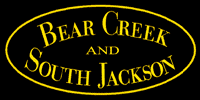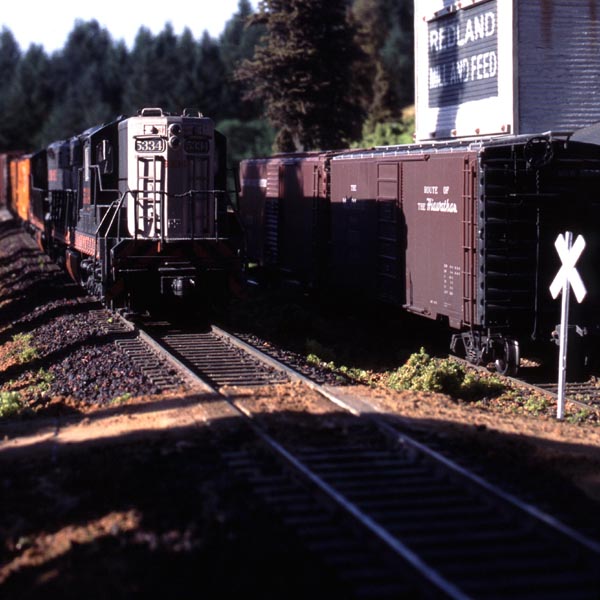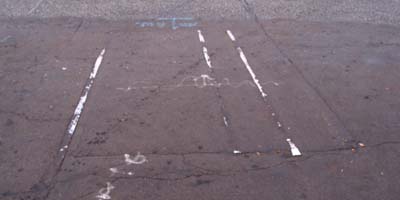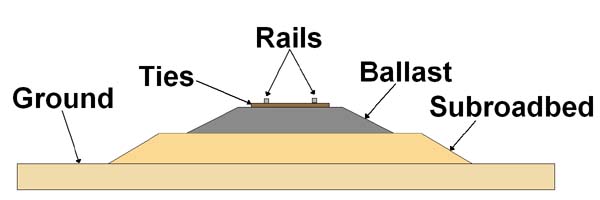 |
 |
 |
 |
 |
 |
What is the best kind of flex track? The answer is "it depends". Do you car about appearance? Or are you more interested getting things running (and want to spend as little money as possible)? What about ease of installation? The following are my opinions of several types of HO flex track (sorry I don't know much about N scale track) In my opinion Micro Engineering makes the best looking flex track (HO anyway) available today. Their spike head detail is only a bit large. And the width of their rail head is quite reasonable. However, you'll pay more for their track and it can be tricky to install. Atlas code 83 flex is fairly decent looking. Its spike heads are bulbous, but not anywhere near as bad as they used to be. The railhead is a bit wider than prototype rail. Shinohara makes (or made) flex track. It looked almost as good as Micro Engineering but its cost was astronomical (the last batch I saw cost almost $6 per meter compared with ME flex which is around $4.50 per yard). Don't waste your money (unless you can get a good deal on this stuff. If you really want good looking track then go for Micro Engineering. Atlas and Model Power code 100 track. This stuff just doesn't look very good. Huge rail, with huge spike heads, huge ties spaced poorly and very wide railhead. But Atlas code 100 is less expensive than their code 83 and the stuff is rugged. It might be a good choice for a staging yard or other non-visible trackwork. There are other vendors (Peco) but I've not seen their products. |
 Micro Engineering flex track on my Redland diorama |
I have some old HO track that looks kind of yellowish. Is
this ok to use? You probably have some track with brass rails. Brass is an excellent conductor. Unfortunately it oxidizes rapidly and brass oxide is a very poor conductor. If you use this rail you will likely spend a good amount of your hobby time cleaning track to get your locos to run reliably. Of course if you have battery power equipment then this won't be a problem. Nickel silver rail doesn't conduct electricity as well as brass. And it too oxidizes. But Nickel Silver oxide is (moderately) conductive and it doesn't oxidize as rapidly as brass. Do yourself a favor and don't use that brass track except as a scenic detail (such as a pile of old rail stack in a maintenance yard). |
I have a bunch of snap track a friend gave me. Is this ok
to use? The older snap track (without roadbed) is not a good thing to use for a permanent layout.
In the last decade or so snap (or sectional) track has become available with built in road bed that locks together. This is much better quality stuff. The roadbed locking helps a lot with alignment and some brands have additional electrical connections. But it costs more and you're still restricted to only the radii and lengths the manufacturer provides. So I recommend staying away from this stuff unless you're laying track on the living room floor so little Jimmy can run his trains around the Christmas tree. |
How many feeder wires do I need to use? Feeder wires are used to connect your power pack or DCC booster to the track. With DCC it is a good idea to use bus wires (I used 12 gauge stranded bus wires) and drop the feeder wires from the rails to the bus. You should have a feeder wire soldered to each piece of rail that is not soldered to a piece of rail that has a feeder wire soldered to it. DON'T depend on rail joiners to conduct track power between pieces of rail. |
Should I solder every piece of rail together? That depends. As temperature goes up and down the rail will expand and contract. As temperature and humidity go up and down your benchwork and roadbed will expand and contract. You'll need to leave some unsoldered rail joints to allow for expansion and contraction. I usually solder two pieces of flex track together using a single set of feeders for it (6 feet). Then I'll use an unsoldered railjoiner with a small gap (about 1/16") between it and the next piece(s) of track. |
What are heat kinks? If the rails get very hot they expand quite a bit. At the same time the benchwork is likely to be drying out and shrinking. This can result in the rails becoming too long for the space they have. Something has to give and the ends of the rails break loose kinking to the side or upward. In one example I've seen a friend built a yard across the inside of his garage door (his layout was in a 2 car garage). During the summer it was very hot so he opened the garage door to let in some ventilation. However, the sun could now shine directly on the track work. It didn't take long before the ends of his flex track had buckled over a half inch into the air! Luckily when it cooled down the rails returned to their normal position. |
What is standard gauge track? In North America when railroads were first started the was little agreement on the proper distance between the rails. This confusion made it impossible for many railroads to share cars. When a cargo reached the end of railroad A it would be unloaded and then reloaded into a car on railroad B. Needless to say this was inefficient and caused delays. The railroads finally standardized on 4' 8 1/2" as their "standard gauge". |
What is narrow gauge? In the last third of the 1800's railroads were springing up all over the place. Often times they were financed by a town that was worried about missing out on the railroad boom. Without access to a railroad a town could die. Building a railroad however was (and still is) a costly affair Narrow guage (often but not always with 3' between the rails instead of the standard 4'8 1/2") offered a measure of economy. The right of way could be a little narrower. The track didn't need to be quite as heavy duty. And a narrow gauge train could go around sharper curves than standard gauge trains (which made narrow gauge especially attractive in mountainous terrain and for logging railroads). Today almost all narrow gauge track is gone. It became apparent that the increased carrying capacity of full size equipment more than offset the supposedly lower costs of a narrow gauge operation. There are still a few narrow gauge railroads in operation but they are mostly tourist railroads. Of these some of the most spectacular thread their tracks through the Colorado rockies. 3' gage railroads were built in Colorado, California, and a number of other places. Maine was the home of a number of 2' narrow gauge railroads that featured almost toy-like equipment it was so small when compared to standard gauge. |
What do Nn3, HOn3, Sn3, or On3 mean? Respecively they stand for 3' gauge track in N scale, HO scale, S scale, and O scale. HOn2 and On2 would be 2' gauge in HO scale and O scale. To confuse matters however there are other designations such as HOn30 or On30 which is 30" narrow gauge. Despite the fact that there were hardly any main stream 30" narrow gauge railroads in real life (mostly there were mining railroads) On30 has gained in popularity recently because it is O scale equipment that operates on HO scale track. HOn30 operates on N scale track. Some people use HOn30 as a good-enough compromise to model 2' narrow gauge. |
What is dual-guage track? Sometime standard gauge and narrow gauge track shared the same roadbed. This was especially true in places where standard and narrow gauge railroads connected in a town. It also happened when a railroad was converting from narrow gauge to standard gauge when both gauges were supported for a time. When this occurs usually one of the rails is "common" and is used by both track gauges. This track is mostly gone now. But sometimes little bits and pieces of it show up where least expected. This little snippet of dual gauge is revealed by the pavement near the Brooklyn Yard in Portland. Apparently there were narrow gauge trolley cars in the area at some point in the past... |

A fragment of dual-gauge track left in the pavement at the corner of SE Mall and SE 17th near the Brooklyn Roundhouse in Portland, Oregon. |
What is subroad bed? It's what goes under the trackwork that provides the structural support to hold it up. I've used plywood and masonite spline for subroadbed. Others have used homasote spline or wood spline. Some have used rigid extruded foam (it comes in slabs at the lumberyard often pink or blue) for subroadbed. The track sits on the subroadbed, often with some kind of roadbed (cork, foam tape, homasote) that holds the track above the surface of the roadbed (real railroad track is usually a foot or two or more above the ground level next to the track. It's held in place by the ballast which allows drainage). Sometimes, I put track directly on plywood if I'm modeling spur tracks that have been smooshed down into the ground through decades of use until the balast and ties have disappeared into the ground leaving only the rails visible. |
How can I model roadbed and a ballast shoulder? In HO scale I use 1/4" cork roadbed for mainlines, 1/8" cork roadbed for sidings and some spurs and no roadbed for other spur tracks. |

Trackwork layers. |